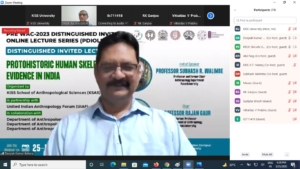Pre WAC-2023 Distinguished Invited Online Lecture #9
Lecture on Protohistoric Human Skeletal Evidence in India
The Pre-World Anthropology Congress Distinguished Invited Online Lecture Series #9 was organized by the Kalinga Institute of Social Sciences (KISS) on 25th March 2022. The lecture was delivered by Prof. Subhash R Walimbe, Anthropology Department, Pune University.
In his welcome address, Professor Deepak Kumar Behera, Vice-Chancellor of KISS-DU, presented an account of the eight stellar Pre-WAC Distinguished Invited Online Lectures delivered by eminent scholars across the world. Professor S. Gregory, Member Secretary, United Indian Anthropology Forum (UIAF) elucidated the multiple core thematic and research domains, as also the sub-themes to be explored at the upcoming World Anthropology Congress (WAC) 2023, describing it as a unique platform for the exchange of anthropological knowledge, and popularization of the subject.
Introducing the speaker, Professor Ashok Kumar Mohapatra, Senior Professor, KISS-DU informed the audience of the unique facilities developed by Professor Walimbe, and spoke about his research activities and accomplishments, spanning a historical period from 8000 BCE to 800 AD.
Professor Rajan Gaur, a leading academician and prolific author in the field of biological anthropology, chaired the event. He thanked the various partners and collaborators of the World Anthropology Congress, particularly, KISS-DU, for making the event possible.
In his lecture, Professor Walimbe described exciting findings based on adult and sub-adult skeletal remains from the hunter-gatherer Mesolithic to the Iron Age Megalithic populations, and how autochthonous data and population movements could be inferred from these. He discussed anatomical differences and changes in skeletal morphology between pre-agricultural and agricultural populations, including cranial and post-cranial robusticity, reduced stature, increased cranial height, and evolution from dolichocrany to brachycrany.
In his fascinating lecture, he described how research foci have shifted from craniometry to an analysis of genetic, climatic and non-genetic factors as non-metric approaches. Bio-anthropological insight enabled the inclusion of important evidence in the form of fragile bones, which were usually discarded during the era of craniometry. A bio-cultural perspective is now preferred.
Professor Walimbe proceeded to unfold a riveting story; of the field of osteobiography, which is reading life histories written on bone, which may tell us more about the origin, fate, and physical appearance of protohistoric humans.
Then, he told the audience how the origin of agriculture became a focal point of change in the cultural evolutionary history of humans, where surplus economy and development of tools reduced masticatory stress, possibly contributing to a more gracile face with comparatively reduced teeth. A population explosion occurred, leading to the development of habitats and sedentary lifestyles, but increased vulnerability to infections as well, particularly from the chalcolithic era onwards. This translated into a high infant mortality rate and low life expectancy. This aspect was also reflected in the mothers’ reproductive history and health. He introduced the subject of Paleopathology, which attempts to study these phenomena.
Pathologic lesions and anomalies are important clues regarding contemporary events. Indicators of growth disturbances are evident in bone including specific and non-specific infections, nutritional stress, neoplasias, and dental and degenerative pathologies. Mechanical asymmetries and differential morphologies also indicate occupational preferences. Thus, there is a wealth of information to be mined from ancient skeletal remains.
The speaker then discussed how these infections led to protohistoric medicinal systems, and how the ministrations of healers are evident in skeletal remains. He also let the audience know that the Global history of health project was a mega-project aimed at preparing a protohistoric health index using multiple indicators, which would be a rich source of information for continuing research in the field.
He described a general lack of awareness of the significance of skeletal remains across the world and concluded by stressing the need for a central skeletal repository and advanced training for personnel.
A lively round of discussion and deliberations followed, led by the Chairperson, who pointed out that a wealth of information could be gleaned from closer scrutiny of skeletal remains. The speaker responded to requests for clarifications from all attendees with detailed and erudite responses based on his extensive and varied research experience.
Dr. Sushree Sangita Mohanty, Assistant Professor, KISS-DU proposed a formal vote of thanks. The event received an overwhelming response from 125 participants.











